Skip to content 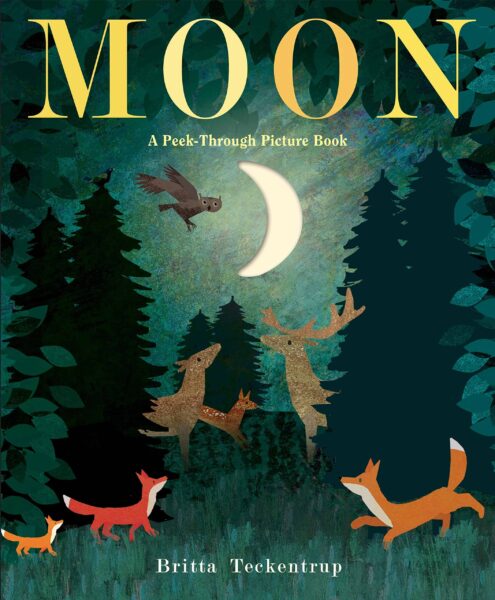
Moon: A Peek-Through Picture Book
By Britta Teckentrup
Over deserts and forests, Arctic tundra and tropical beaches, the moon shines down on creatures around the world. Children will discover how it changes from day to day as the lunar cycle is shown through peek-through holes, each revealing the moon in a different size and shape. 3-7 years

Moon! Earth’s Best Friend
By Stacy McAnulty, Illustrated by Stevie Lewis
Meet Moon! She’s more than just a rock―she’s Earth’s rock, her best friend she can always count on. She never turns her back on her friend (literally: she’s always facing Earth with the same side!) These two will stick together forever. With humor and charm, Stacy McAnulty channels the voice of Moon in this celestial “autobiography” in the Our Universe series. 4-8 years
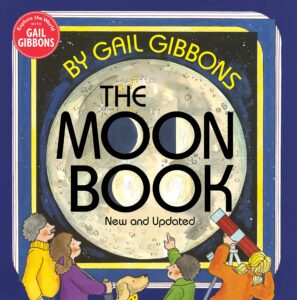
The Moon Book
By Gail Gibbons
An up-to-date, clear and interesting introduction to our magnificent moon from the the award-winning author of science books for children. Shining light on all kinds of fascinating facts, this simple, introductory book includes information on how the moon affects the oceans’ tides, why the same side of the moon always faces earth, why we have eclipses, and more. 4-8 years
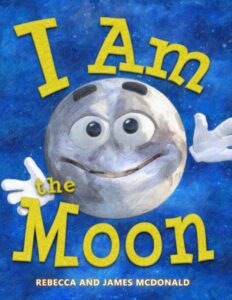
I Am the Moon
By Rebecca and James McDonald
Put on your spacesuit and helmet. Children ages will learn easy to follow facts through imaginative illustrations.
The Moon is beautiful to look at in the night sky, and it also plays an important part in the cycle of life on Earth. And maybe someday it will be a place people call home. This book is a great starting point for teaching young children the basics. Colorful illustrations and facts explained in a fun and easy to follow way keep children’s attention. 3-5 years

How We Got to the Moon: The People, Technology, and Daring Feat of Science Behind Humanity’s Greatest Adventure
By John Rocco
Everyone knows of Neil Armstrong’s famous first steps on the moon. But what did it really take to get us there?
From the shocking launch of the Russian satellite Sputnik to the triumphant splashdown of Apollo 11, Caldecott Honor winner John Rocco answers every possible question about this world-altering mission. Each challenging step in the space race is revealed, examined, and displayed through diagrams, experiments, moments of crisis, and unforgettable human stories. Explorers of all ages will want to pour over every page in this book detailing the grandest human adventure of all time! 10 and up

Next Time You See the Moon
By Emily Morgan
Children will learn about many of the Moon’s mysteries: what makes it look like a silvery crescent one time and a chalk-white ball a few nights later, why it sometimes appears in the daytime, the science behind its shape, where it gets its light and how scientists can predict its shape on your birthday a thousand years from now. 5-10 years

Once in a Full Moon
By Carolinda Goodman, Illustrated by Mariia Luzina
Once a month a full moon rises in the night sky. But every time it does, this big gleaming circle has a different name! From January’s Wolf Moon to June’s Strawberry Moon to the Harvest Moon of September, in lively rhyme, this book tells the stories behind this monthly visitor, many of which come from Native American tradition. 3-7 years
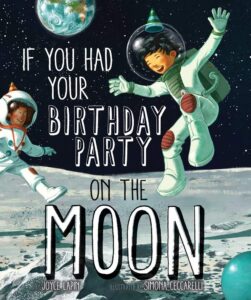
If You Had Your Birthday Party on the Moon
By Joyce Lapin, Illustrated by Simona Ceccarelli
Have your birthday party on the moon and everyone will come! After all, who wouldn’t want to ride in a rocket and celebrate for a day that lasts as long as a month on Earth? Then, young partygoers could romp in a low-gravity playground; watch candles and balloons behave weirdly in the atmosphere; and see why the “moon angels” they make in the thick carpet of lunar dust will last for thousands of years. With each discovery, kids learn the science behind the surprise. Complete with sidebars and a glossary, this adventure is perfect for sharing at home and at school. 7 and up

50 Things to See on the Moon: A First-Time Stargazer’s Guide
By John A. Read
The moon is our nearest neighbor in space, it’s easy to find, it’s bright, and you don’t have to go anywhere special to view it. Astronomer John A. Read has selected fifty of the best things to see — organized by the phases of the Moon. As each day passes, an additional slice becomes visible. With each slice comes new craters, lunar seas, and jagged mountain ranges. This book is for a first-time stargazer who is curious about what is up there. 5-7 years
The book descriptions used are primarily from the publishers.
If you like this post, then please consider sharing it and/or leaving a comment below. Thank you! Barbara Lowell, Children’s Author
You may like, Kids Books: Exploring Mars
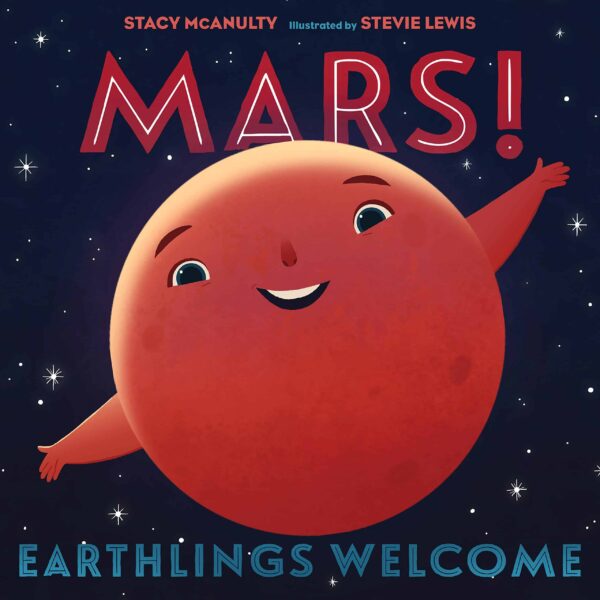
Mars! Earthlings Welcome
By Stacy McAnulty, Illustrated by Stevie Lewis
Meet Mars! The red planet. Planet Marvelous. Favorite sibling of Earth (or so he claims). Sometimes they’re close (just 34.5 million miles apart). Sometimes they need space (250 million miles apart). Earth and Mars have a lot in common―clouds, mountains, polar icecaps. And while Earth has Earthlings, Mars makes a persuasive case for why people should make the journey to spend time with him. His day is 7 minutes longer. He is home to the largest volcano in the whole solar system. He’s, well, marvelous. 4-8 years
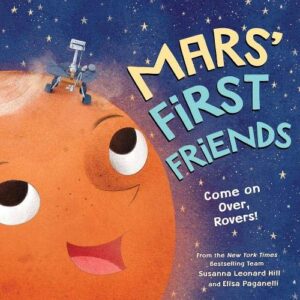
Mars First Friends: Come on Over Rovers!
By Susanna Leonard Hill, Illustrated by Elisa Paganelli
In a solar system full of planets, Mars feels all alone. All Mars wants is someone to play with, but all of the planets are just too busy. Mars can’t help but wonder…will he ever get a playmate? Until one day, Earth sends her little brother Mars his first friends: the rovers Spirit and Opportunity.
Learn about Mars’ rovers through this universal story about man’s―and Mars’―best friends―our beloved pets. This solar system book is the perfect book for little adventurers searching for more books on pets and space books for kids. 4-8 years

Curiosity: The Story of a Mars Rover
By Markus Motum
Maybe you remember when a little robotic spacecraft landed on a far-off planet. On August 6, 2012, the rover Curiosity touched down on the rocky surface of Mars — and now she’s ready to guide you through her journey firsthand. From idea to creation and beyond, this fact-filled book introduces readers to Curiosity and her mission: to discover more about the red planet and search for evidence of life.
How did Curiosity get her name? What tools does she use to carry out her tasks? In her own voice, the popular NASA rover tells how and why she traveled more than 350,000,000 miles to explore a planet no human has ever visited . . . and what she’s been doing there. 8-12 years
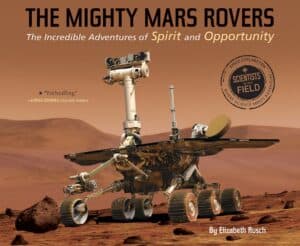
The Mighty Mars Rover: The Incredible Adventures of Spirt and Opportunity
By Elizabeth Rusch
On June 10, 2003, a little rover named Spirit blasted off on a rocket headed for Mars. On July 7, 2003, a twin rover named Opportunity soared through the solar system with the same mission: to find out if Mars ever had water that could have supported life. The Mighty Mars Rovers tells the story of the greatest space robot adventure of all time through the eyes—and heart—of Steven Squyres, professor of astronomy at Cornell University and lead scientist on the mission. This book captures the hair-raising human emotions felt during the adventures with two tough rovers. 10-12 years
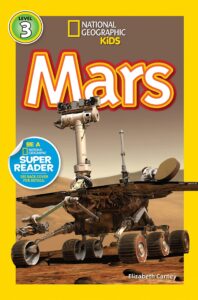
National Geographic Reader: Mars
By Elizabeth Carney
Discover the fascinating world of Mars in this colorful book. In this format, kids will learn about the newest information on Mars, the Mars Rover, and our ongoing exploration of the Red Planet. This level 3 reader is written in an easy-to-grasp style to encourage the scientists and explorers of tomorrow! 6-9 years

Rover Throws a Party
Kristin L. Gray, Illustrated by Scott Magoon
It’s Rover’s anniversary on Mars! Time to celebrate by throwing the best party this planet has ever seen. Rover hands out invitations all over town, but it seems like he’s the only one around. Will anyone come to the party, or will Rover be all alone on his big day?
In 2013, NASA programmed their Curiosity rover to hum “Happy Birthday to You” in honor of its first year on Mars. Inspired by this anecdote, this is the tale of a lonely rover and his party, accompanied by fascinating Mars rover facts that help explain the real science behind the story. This fun birthday tale provides an accessible, kid-friendly look at one of NASA’s coolest programs. 3-7 years

Night Night, Curiosity
By Brianna Caplan, Illustrated by Ryan O’Rourke
In this rhyming bedtime book, a girl whose mother works at NASA imagines that she’s exploring Mars with the Curiosity rover as she gets ready for bed. She describes taking off, observing Mars, communicating with mission control, and operating the rover. Young space explorers everywhere will want to head for Mars, too. 3-7 years
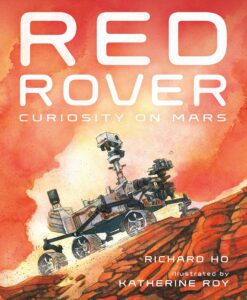
Red Rover: Curiosity on Mars
By Richard Ho, Illustrated by Katherine Roy
Mars has a visitor. It likes to roam…observe…measure…and collect. It explores the red landscape―crossing plains, climbing hills, and tracing the bottoms of craters―in search of water and life. It is not the first to visit Mars. It will not be the last. But it might be…the most curious. Join Curiosity on its journey across the red planet in this nonfiction picture book by Richard Ho, illustrated by Sibert Honor winner Katherine Roy. 3-6 years

Spirit and Oppy
By Rachel Viniguerra, Illustrated by Samantha Gottwalt
Have you heard the story of the twin sisters who explored the surface of Mars? They were NASA’s twin rovers, Spirit and Opportunity (or Oppy for short). The two sisters traveled to Mars in 2003 and explored the vast planet. Although Oppy’s mission was only meant to last 90 days, she explored for 15 years overcoming obstacles with creative solutions. The sisters showed the world just how much two small rovers can do right up until the end of their missions. 5-9 years

Exploring Space: From Galileo to the Mars Rover and Beyond
By Martin Jenkins, Illustrated by Stephen Biesty
For centuries, humans have looked up at the night sky and wondered what it’s like deep in space, far from Earth — and now we’ve begun to find out. We’ve landed on the moon, put robots on Mars, and sent space probes billions of miles to explore the far reaches of our solar system. Find out what life is like on the International Space Station, what the chances are that we will ever settle on Mars, where in the solar system we might find alien life, and why visiting other stars will almost certainly remain a dream. Budding astronomers, junior astronauts, and anyone who has ever gazed up at the stars will enjoy this glimpse of the infinite wonders of space. 8-12 years
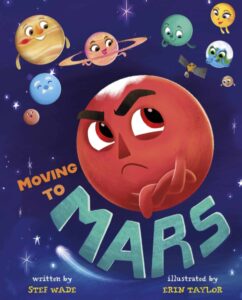
Moving to Mars
By Stef Wade, Illustrated by Erin Taylor
Mars likes peace and quiet and is not happy when unexpected visitors start showing up. But when they leave, Mars realizes being alone isn’t all that great. Mars reaches out to his space friends for comfort and help. Maybe Mars is a people planet after all! Author Stef Wade (A Place for Pluto) interweaves friendship and humor throughout the space story and seamlessly connects nonfiction information to the narrative in the back matter. 5-7 years
The book descriptions used are primarily from the publishers.
If you like this post, then please consider sharing it and/or leaving a comment below. Thank you! Barbara Lowell, Children’s Author
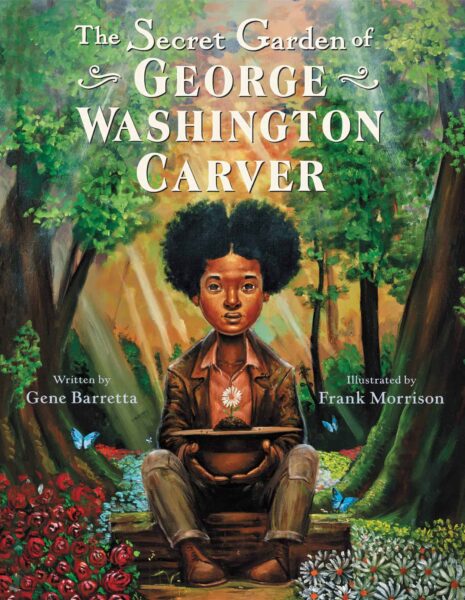
The Secret Garden of George Washington Carver
By Gene Barretta, Illustrated by Frank Morrison
When George Washington Carver was just a young child, he had a secret: a garden of his own.
Here, he rolled dirt between his fingers to check if plants needed more rain or sun. He protected roots through harsh winters, so plants could be reborn in the spring. He trimmed flowers, spread soil, studied life cycles. And it was in this very place that George’s love of nature sprouted into something so much more—his future.
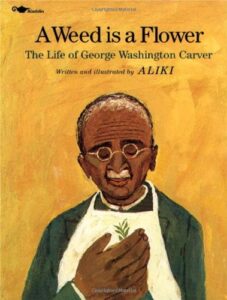
A Weed is a Flower: The Life of George Washington Carver
By Aliki
Discover how George Washington Carver went from a slave to an innovator of agricultural science in this illustrated picture book. Born a slave, he went on to become the most prominent black scientist of the early twentieth century.

I Am George Washington Carver
By Brooke Vitale
With the help of inventor, painter, musician, and botanist George Washington Carver, Brad, Xavier, and Yadina come together to learn how to take care of the Earth.

Who Was George Washington Carver?
By Jim Gigliotti, Illustrated by Stephen Marchesi
Born in 1860s Missouri, nobody expected George Washington Carver to succeed. Slaves were not allowed to be educated. After the Civil War, Carver enrolled in classes and proved to be a star student. He became the first black student at Iowa State Agricultural College and later its first black professor. He went on to the Tuskegee Institute where he specialized in botany (the study of plants) and developed techniques to grow crops better. His work with vegetables, especially peanuts, made him famous and changed agriculture forever. He went on to develop nearly 100 household products and over 100 recipes using peanuts.
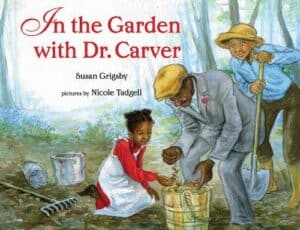
In the Garden with Dr. Carver
By Susan Grigsby, Illustrated by Nicole Tadgell
Sally is a young girl living in rural Alabama in the early 1900s, a time when people were struggling to grow food in soil that had been depleted by years of cotton production. One day, Dr. George Washington Carver shows up to help the grown-ups with their farms and the children with their school garden. He teaches them how to restore the soil and respect the balance of nature. He even prepares a delicious lunch made of plants, including “chicken” made from peanuts. Sally never forgets the lessons this wise man leaves in her heart and mind. Susan Grigsby’s warm story shines new light on a Black scientist who was ahead of his time.
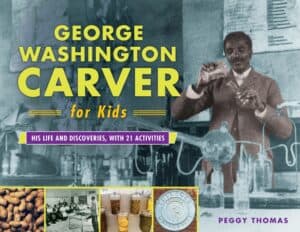
George Washington Carver: His Life and Discoveries with 21 Activities
By Peggy Thomas
George Washington Carver was a scientist, educator, artist, inventor, and humanitarian. Born into slavery during the Civil War, he later pursued an education and would become the first black graduate from Iowa Agricultural College. Carver then took a teaching position at the Tuskegee Institute, founded by Booker T. Washington. There, Carver taught poor Southern farmers how to nourish the soil, conserve resources, and feed their families. He also developed hundreds of new products from the sweet potato, peanut, and other crops, and his discoveries gained him a place in the national spotlight.
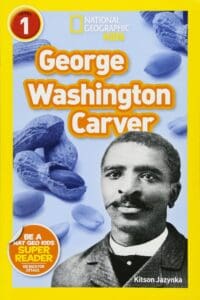
George Washington Carver National Geographic Reader
By Kitson Jazynka
Take a bite into the fascinating history of peanut butter and the man who invented it. Through leveled text and engaging photos, kids meet George Washington Carver and learn about his important work with peanuts and other plants. This level 1 reader is carefully leveled for an early independent reading or read aloud experience, perfect to encourage the scientists and explorers of tomorrow!
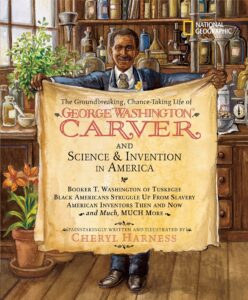
The Groundbreaking, Chance-Taking Life of George Washington Carver and Science and Invention
By Cheryl Harness
This is the inspiring story of a man who rose from slavery to worldwide fame as America’s Plant Doctor. Follow the action as Confederate raiders kidnap young Carver-along with his mother and siblings-and sell them to Arkansas slaveholders. Here, whooping cough threatens George’s life, yet the disease will be the key to his future. Unable to work in the fields, he spends his days studying plants. His desire for knowledge leads him to the rich farmlands of Iowa, where he becomes the first black student-and later the first black faculty member-at the state university.
Carver pioneers hundreds of new uses for plants and revolutionizes American agriculture by teaching farmers the value of rotating cotton with nitrogen-rich crops. Our hero dines at the White House, works with Henry Ford, and testifies to Congress. The book’s vivid illustrations are an invitation to step back in time and become an active participant in this compelling story.

George Washington Carver: More Than “The Peanut Man”
By Janet Rodriquez, Illustrated by Subi Bosa
Born enslaved during the Civil War in Diamond, Missouri, George Washington Carver was an agricultural scientist and inventor. He promoted alternative crops to cotton and methods to prevent soil depletion. Among his many accomplishments, he developed more than 300 industrial and commercial products from peanuts. It is time to remember how George Washington Carver’s inventions and his contributions changed our society… and our world! 8-10 years
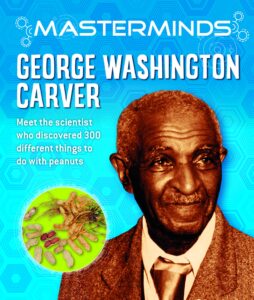
Masterminds: George Washington Carver
By Izzi Howell
George Washington Carver was born a slave, but became one of the most prominent scientists and inventors in U.S. history. As an agricultural scientist, Carver promoted the idea of growing peanuts and sweet potatoes to be used in over a hundred different ways. He also spent his time championing various efforts in agricultural education in the South. Masterminds readers how Carver, made massive contributions to his field and how his story and discoveries remain relevant today.

Fantastic Kids: George Washington Carver
By Michelle Jovin
George Washington Carver was born into slavery. No one thought much of him because he was sick and weak. He would spend his life proving them wrong. Learn more about the “Plant Doctor” turned “Peanut Man” and how he helped people across the United States. This biography includes a glossary and a table of contents to engage students in reading as they develop their comprehension and literacy skills. This book aligns with national and state standards and features TIME For Kids content to keep grade 2 students engaged in learning.
The book descriptions used are primarily from the publishers.
If you like this post, then please consider sharing it and/or leaving a comment below. Thank you! Barbara Lowell, Children’s Author
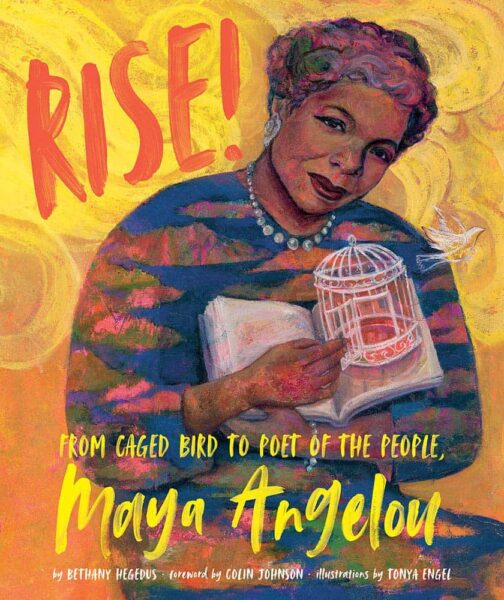
BOOKS FOR KIDS: MAYA ANGELOU
Rise! From Caged Bird to Poet of the People, Maya Angelou
By Bethany Hegedus, Illustrated by Tonya Engel
Writer, activist, trolley car conductor, dancer, mother, and humanitarian Maya Angelou’s life was marked by transformation and perseverance. In this picture-book biography geared towards older readers, Bethany Hegedus lyrically traces Maya’s life from her early days in Stamps, Arkansas, through her work as a freedom fighter to her triumphant rise as a poet of the people.
A foreword by Angelou’s grandson, Colin A. Johnson, describes how a love of literature and poetry helped young Maya overcome childhood trauma and turn adversity into triumph. Coupled with Tonya Engel’s metaphorical and emotive illustrations, this biography beautifully conveys the heartaches and successes of this truly phenomenal woman, and is a powerful tribute to the written word.

Who Was Maya Angelou?
By Ellen Labrecque, Illustrated by Dede Putra
Born in Missouri in 1928, Maya Angelou had a difficult childhood. Jim Crow laws segregated blacks and whites in the South. Her family life was unstable at times. But much like her poem, “Still I Rise,” Angelou was able to lift herself out of her situation and flourish. She moved to California and became the first black—and first female—streetcar operator before following her interest in dance. She became a professional performer in her twenties and toured the U.S. and Europe as an opera star and calypso dancer. But Angelou’s writing became her defining talent. Her poems and books, including I Know Why the Caged Bird Sings, brought her international acclaim.
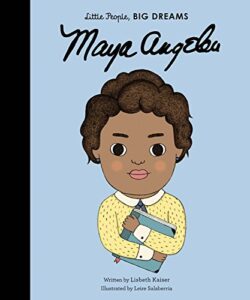
Maya Angelou, Little People Big Dreams
By Lisbeth Kaiser, Illustrated by Leire Salaberria
Maya Angelou spent much of her childhood in Stamps, Arkansas. After a traumatic event at age eight, she stopped speaking for five years. However, Maya rediscovered her voice through wonderful books, and went on to become one of the world’s most beloved writers and speakers. This book features stylish and quirky illustrations and extra facts at the back, including a biographical timeline with historical photos and a detailed profile of Maya Angelou’s life.

Maya Angelou, My Itty-Bitty Bio
By Emma E. Haldy, Illustrated by Jeff Bane
The My Itty-Bitty Bio series are biographies for the earliest readers. This book examines the life of Maya Angelou in a simple, age-appropriate way that will help children develop word recognition and reading skills. Includes a timeline and other informative backmatter.
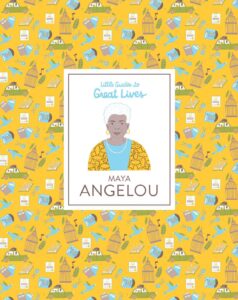
Maya Angelou, Little Guides to Great Lives
By Danielle Jawando, Illustrated by Snir Noa
Maya Angelou was an African–American author, poet, playwright and civil rights activist. She wrote seven autobiographies, three books of essays, several books of poetry, and a long list of plays, films and television shows. Never taking “No” for an answer, Maya used her voice and her art to overcome prejudice and difficulty and to become an inspiration to those around her and to future generations.
Her story is a rich and remarkable one – a tale filled with strength, hardship and hope. Maya learned the importance of using her own voice to help others and change the world!
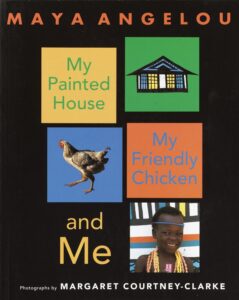
My Painted House, My Friendly Chicken, and Me
By Maya Angelou, Illustrated by Margaret Courtney-Clarke
Full color photographs. “Hello, Stranger-Friend” begins Maya Angelou’s story about Thandi, a South African Ndebele girl, her mischievous brother, her beloved chicken, and the astonishing mural art produced by the women of her tribe. With never-before-seen photographs of the very private Ndebele women and their paintings, this unique book shows the passing of traditions from parent to child and introduces young readers to a new culture through a new friend.
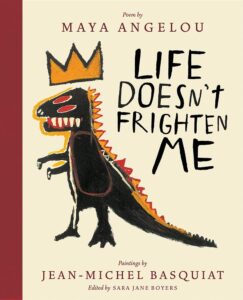
Life Doesn’t Frighten Me
By Maya Angelou, Illustrated by Jean-Michel Basquiat
Shadows on the wall
Noises down the hall
Life doesn’t frighten me at all
Maya Angelou’s brave, defiant poem celebrates the courage within each of us, young and old. From the scary thought of panthers in the park to the unsettling scene of a new classroom, fearsome images are summoned and dispelled by the power of faith in ourselves.
The book descriptions used are primarily from the publishers.
If you like this post, then please consider sharing it and/or leaving a comment below. Thank you! Barbara Lowell, Children’s Author
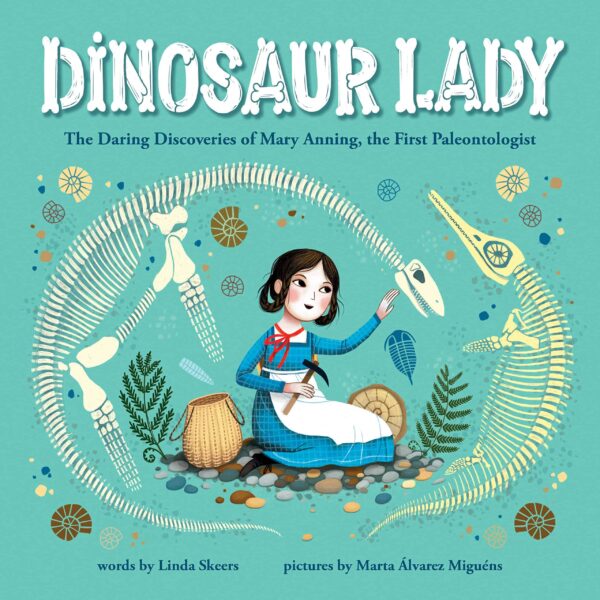
Dinosaur Lady: The Daring Discoveries of Mary Anning, The First Paleontologist
By Linda Skeers, Illustrated by Marta Alvarez Miguéns
Mary Anning loved scouring the beach near her home in England for shells and fossils. She fearlessly climbed over crumbling cliffs and rocky peaks, searching for new specimens. One day, something caught Mary’s eye.
Bones. Dinosaur Bones.
Mary’s discoveries rocked the world of science and helped create a brand-new field of study: paleontology. But many people believed women couldn’t be scientists, so Mary wasn’t given the credit she deserved. Nevertheless, Mary kept looking and learning more, making discoveries that reshaped scientific beliefs about the natural world. Grades 1-4

Mary Anning’s Curiosity
By Monica Kulling, Illustrated by Melissa Castrillon
Mary Anning, considered the world’s greatest fossilist, discovered her first big find at the age of twelve. This novel is an imaginative recreation of her childhood in early nineteenth-century Lyme Regis. Grades 2-7
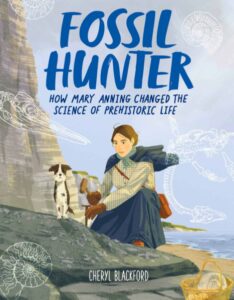
Fossil Hunter: How Mary Anning Changed the Science of Prehistoric Life
By Cheryl Blackford
Mary Anning grew up on the south coast of England in a region rich in fossils. As teenagers, she and her brother Joseph discovered England’s first complete ichthyosaur. Poor and uneducated, Anning would become one of the most celebrated paleontologists ever, though in her time she supported herself selling by fossils and received little formal recognition. Her findings helped shape scientific thinking about extinction and prehistoric life long before Darwin published his famous work on evolution.
With photographs, and paleoart, Fossil Hunter introduces this self-taught scientist, now recognized as one of the greatest fossilists the world has ever known. Grade 5+
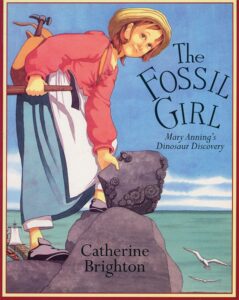
The Fossil Girl
By Catherine Brighton
It’s 1811. Ten-year-old Mary Anning, her brother Joe, and their widowed mother are eking out a meager existence running a little fossil shop in the seaside town of Lyme Regis. After a storm wipes out most of the shop’s merchandise, Mary and Joe begin the slow work of restocking the shelves. They search high and low for fossils, and one day Mary spots a huge eye in a cliff face high above the town. She resolves to bring the creature down no matter the risk. The exciting discovery and recovery of the first complete fossil of an Ichthyosaurus is told in a graphic novel format, perfect for reluctant readers. Grades K-3

Rare Treasures: Mary Anning and Her Remarkable Discoveries
By Don Brown
Before the word “dinosaur” was even coined, a young girl discovered a remarkable skeleton on the rocky beach at Lyme Regis in England. Thus began a lifelong passion for an extraordinary woman who became one of the first commercial fossil collectors. Born in 1799, Mary Anning spent a lifetime teaching herself about fossils and combing the rugged ribbon of shore near her home. Her work yielded an astounding treasure trove: fossils of long-extinct creatures that thrilled customers in her shop and excited early paleontologists.
Blind to the dangers of fossil-hunting and to the limitations imposed on women of her era, Mary Anning was a singular scientist who used her sharp eyes and clear mind to compose a picture of ancient life from the bones she unearthed. With his trademark prose and lyrical watercolors, Don Brown distills the life story of this rare treasure of a scientist. Grades Preschool-3
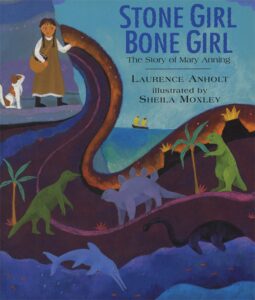
Stone Girl Bone Girl
By Laurence Anhot, Illustrated by Shelia Moxley
Mary Anning, a young girl found a fossilized sea monster, the most important prehistoric discovery of its time. This spectacular tale of a little girl who dared to be different and who followed her dreams will inspire young children. Learn how Mary discovered new fossils – and how her observations rocked the natural history world. Be inspired by Mary’s work as a woman in the field of science – especially as her achievements weren’t recognized until after her death. Grades K-3

History VIPs: Mary Anning
By Kay Barnham
‘She sells sea shells on the sea shore’ – and she really did! This rhyme is thought to have been written about Mary Anning, an amazing fossilist and dinosaur expert, who was almost unknown at the time she lived. This biography explores the life of Mary Anning, from her first fossil finds at the age of ten to her sales of important discoveries to wealthy scientists. Mary’s fossil finds made a great contribution to what scientists understood about pre-historic life.
Through the story of Mary Anning, readers learn about life and society in Victorian Britain. We learn what it was like to be born into a poor family and about the roles of women in society and in the field of science. Grades 4-6
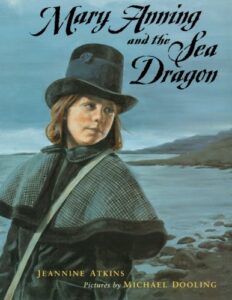
Mary Anning and the Sea Dragon
By Jeannine Atkins, Illustrated by Michael Dooling
Mary Anning loved to scour the shores of Lyme Regis, England, where she was born in 1799, for stone sea lilies and shells. Her father had taught her how to use the tools with which she dug into the sand and scraped at the stones that fell from the cliffs. And he taught her how to look hard for “curiosities.”
One day, when she was eleven, Mary Anning spotted some markings on a wide, flat stone. She chipped at it with her hammer and chisel until the lines of a tooth emerged–and then those of another tooth. Weeks of persistent effort yielded a face about four feet long. But what creature was this? Her brother called it a sea dragon.
Many months later, Mary Anning still had not unearthed what she only then learned was called a fossil. But she found out that her discovery was precious and that the painstaking effort to uncover traces of ancient life was profoundly important. Jeannine Atkins’s engaging portrait is illustrated by Michael Dooling, whose paintings capture young Mary Anning’s devotion to her work, and all the joy she found in it. Grades K-4
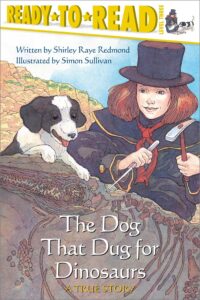
The Dog That Dug for Dinosaurs
By Shirley Raye Redmond, Illustrated by Simon Sullivan
There once was a little dog named Tray. He lived in England with his owner, Mary Ann Anning. Besides Mary Ann, Tray loved one other thing: He loved to dig for dinosaur bones. Together he and Mary Ann found small bones, big bones, and even entire skeletons! People came from all around the world to see the bones they found.
This is the true story of Tray, the dog that dug for dinosaurs. Grades 1-3
The book descriptions used are primarily from the publishers. You will notice that there is a discrepancy in Mary’s age when she found the dinosaur.
If you like this post, then please consider sharing it and/or commenting below. Thank you! Barbara Lowell, Children’s Author
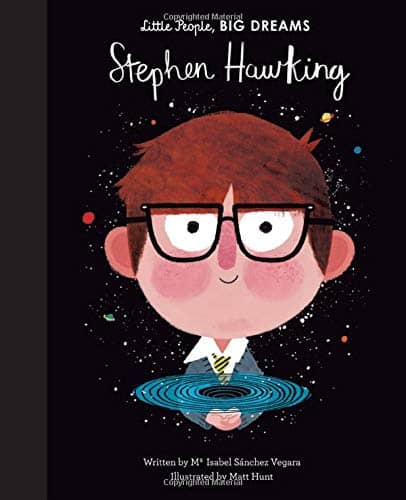
Stephen Hawking
By Maria Isabel Sanchez Vegara
When Stephen Hawking was a little boy, he used to stare up at the stars and wonder about the universe. Although he was never top of the class, his curiosity took him to the best universities in England, Oxford and Cambridge. It also led him to make one of the biggest scientific discoveries of the 20th century, Hawking radiation. This book features stylish and quirky illustrations and extra facts at the back, including a biographical timeline with historical photos and a detailed profile of the brilliant physicist’s life. 4-7 years

Stay Curious: A Brief History of Stephen Hawking
By Kathleen Krull, Illustrated by Paul Brewer
As a young boy, Stephen Hawking loved to read, stargaze, and figure out how things worked. He looked at the world and always asked, Why?
He never lost that curiosity, which led him to make groundbreaking discoveries about the universe as a young man. Even being diagnosed with ALS didn’t slow Stephen down. Those questions kept coming. As his body weakened, Stephen’s mind expanded allowing him to unlock secrets of the universe and become one of the most famous scientists of all time.
Stephen always approached life with courage, a sense of humor, and endless curiosity. His story will encourage readers to look at the world around them with new eyes. 4-8 years

Who Was Stephen Hawking?
By Jim Gigliotti, Illustrated by Gregory Copeland
Stephen Hawking was born exactly three hundred years after the death of the scientist Galileo, so maybe it was written in the stars that he would become a famous scientist in his own right. Although he was diagnosed with a neurological disease at age 21, Stephen did not let the illness define his life.
Known for his groundbreaking work in physics, and identified by his wheelchair and computerized voice system, Stephen continued his research until his death in 2018. He is best known for his black hole theories and his best-selling book A Brief History of Time. Stephen Hawking is an example of a person who had a great mind, but an even greater spirit. 8-12 years
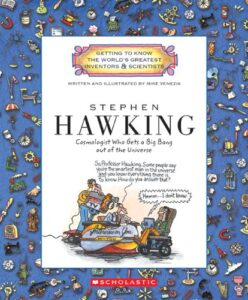
Stephen Hawking: Cosmologist Who Gets a Big Bang Out of the Universe
By Mike Venezia
Meet renowned physicist Stephen Hawking. This book presents the life and work of the British physicist who overcame the challenges of ALS to become one of the foremost scientists of the twentieth century.
This book combines a mix of historical reproductions, photos, and cartoon-style illustrations that bring to life Stephen Hawking’s work and contributions. 6-10 years

All About Stephen Hawking
By Chris Edwards, Illustrated by Amber Calderon
As an Oxford student, Stephen Hawking never expected that people across the world would know his name, or that his hobby of stargazing would lead him to be one of the world’s greatest scientists. Stephen Hawking made cosmology, or the study of the universe, accessible to everyone.
He was diagnosed with amyotrophic lateral sclerosis (ALS) at the age of twenty-one, but didn’t let that stop him from receiving a graduate degree from Cambridge and going on to be an expert in the scientific origin of the universe and black holes. Hawking is best known for writing A Brief History of Time, which explained cosmology in non-scientific terms so that non-scientists could understand it. 10-12 years
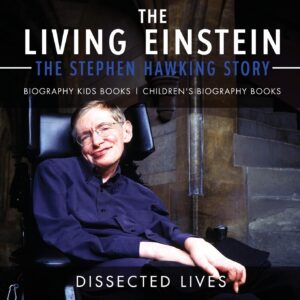
The Living Einstein: The Stephen Hawking Story
By Dissected Lives
Despite his debilitating illness, Stephen Hawking found ways to share his knowledge of the universe. He was a bright man who was always hungry for knowledge. He experimented, studied and explored anything and everything from the physical world to the cosmos. Be inspired by his story. Learn from his discoveries. 8-12 years

Stephen Hawking: A Life Beyond Limits
By Alex Woolf
In 1974, Stephen Hawking shook the world of physics. His theory on black holes went against everything the science community accepted as fact. How did he make such revolutionary discoveries? From a childhood spent building model airplanes to recognition as one of the greatest scientists of his time, Stephen’s genius and endless curiosity powered his work. Find out how this boy who loved science became one of history’s greatest trailblazers! 8-13 years
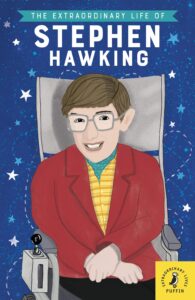
The Extraordinary Life of Stephen Hawking
By Kate Scott, Illustrating by Ester Mols
Stephen Hawking was: a physicist, a cosmologist, an author and one of the cleverest people who ever lived. While studying at Oxford University, Stephen Hawking was diagnosed with motor neurone disease, which meant that eventually he was completely paralyzed, and could only talk via a computer.
But that never held him back, and because of his work on time and space, he changed the way the world thinks about the universe.
Discover more about the life of a man who is known for his incredible contribution to science. 7-12 years

Little Guides to Great Lives: Stephen Hawkings
By Isabel Thomas, Illustrated by Marianna Madiz
Stephen Hawking was one of the world’s most renowned scientists and cosmologists. His ground–breaking research into black holes and the Big Bang has helped to explain the beginnings of our universe and his book A Brief History of Time has sold over 10 million copies. Diagnosed with a form of motor neuron disease when he was a young man, Stephen was inspired to achieve his goals as fast as possible. Through incredible determination and skill, he became a legendary scientist, a best–selling author, and the man that changed the way we think about the universe.
The book descriptions used are primarily from the publishers.
If you like this post, then please consider sharing it and/or leaving a comment below. Thank you! Barbara Lowell, Children’s Author

BEHIND THE BOOKCASE: MIEP GIES, ANNE FRANK AND THE HIDING PLACE
By Barbara Lowell, Illustrated by Valentina Toro
Miep Gies risked her life to keep a secret. Behind the bookcase in her office, stairs led to a hiding place where Anne Frank and her family hid from the Nazis. Once a refugee herself, Miep knew the power of kindness. Her selflessness, humanity, and bravery sheltered Anne for a time. Because of Miep, Anne Frank’s story lives on. –Behind the Bookcase Jacket
YOUNG MIEP GIES
Miep Gies was born in Vienna, Austria, in 1909. Her name was Hermine Santrouschitz. After Austria’s loss in World War I, food was scarce and Miep became malnourished as many of Austria’s children did. Her parents were concerned that their eleven-year-old daughter might die.
Along with other families in the Netherlands, the Nieuwenhuises offered to take care of an Austrian child. Miep’s parents sent her to Leiden to live with the Dutch family. They called her Hermine at first, but then gave her the “affectionate Dutch nickname” Miep. Soon, Mr. and Mrs. Neiuwenhuise began to think of Miep as their adoptive child and the four boys in the family referred to her as one of their two sisters.
Through their kindness and lots of Dutch bread, butter, milk, cheese and chocolate, Miep grew healthy. Her foster father took her to school where the children grabbed her hands, sat her down, and taught her to speak Dutch. Soon, Miep was the top student in her class.
Miep embraced the Dutch life. She rode a bicycle for the first time, learned to make butter sandwiches, talked about what she read in the newspaper and learned to love classical music. But ice skating on a frozen canal was something she tried once but would never try again.
When she was thirteen, Miep and her new family moved to Amsterdam. She loved its movie theaters, electric streetcars, the canals winding through the city, the beautiful flower stalls, and all the bicycles racing along the city’s bike paths.
When she was sixteen, she visited her Austrian family. Miep told them that she had grown to love living in Amsterdam and wanted to stay there. She considered herself to be Dutch now. Her parents gave their permission and Miep returned to Amsterdam and her life with the Nieuwenhuise family. In 1941, she married Jan Gies. From the time she was eleven until her death in 2010, at age 100, Miep Gies lived a proud Dutch life.

America is Under Attack: September 11, 2001 the Day the Towers Fell
By Don Brown
The events of September 11, 2001, changed the world forever. Don Brown narrates the events of the day in a way that is both accessible and understandable for young readers. Straightforward and honest, this account moves chronologically through the morning, from the terrorist plane hijackings to the crashes at the World Trade Center, the Pentagon, and in Pennsylvania; from the rescue operations at the WTC site in New York City to the collapse of the buildings. Watercolor illustrations capture the emotion and pathos of the tragedy making this an important book about an unforgettable day in American history. Grades 1-4

Survivor Tree
By Marcie Colleen, Illustrated by Aaron Becker
This hopeful story of a resilient tree that grew (and still grows) at the base of the twin towers is a simple introduction for young readers to gain an understanding of September 11th and the impact it had on America.
One September day, the perfect blue sky exploded. Dust billowed. Buildings crumbled. And underneath it all, a tree sprouted green leaves in its distress. Pulled from the wreckage, the tree saw many seasons pass as it slowly recovered far away from home. Until one day, forever scarred and forever stronger, it was replanted at the 9/11 Memorial.
This story of the real Survivor Tree uses nature’s cycle of colors to reflect on the hope and healing that come after a tragedy—and assures readers of their own remarkable resilience. 4-8 years
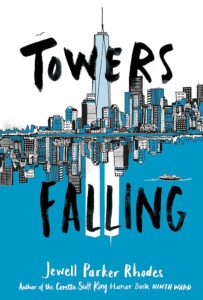
Towers Falling
By Jewell Parker Rhodes
When her fifth-grade teacher hints that a series of lessons about home and community will culminate with one big answer about two tall towers once visible outside their classroom window, Dèja can’t help but feel confused. She sets off on a journey of discovery, with new friends Ben and Sabeen by her side. But just as she gets closer to answering big questions about who she is, what America means, and how communities can grow and heal, she uncovers new questions. Like, why does Pop get so angry when she brings up anything about the towers?
Jewell Parker Rhodes tells a story about young people who weren’t alive to witness this defining moment in history, but begin to realize how much it colors their every day. Grades 3-7

What Were the Twin Towers
By Jim O’Connor, Illustrated by Ted Hammond
Discover the true story of the Twin Towers—how they came to be the tallest buildings in the world and why they were destroyed.
When the Twin Towers were built in 1973, they were billed as an architectural wonder. At 1,368 feet, they clocked in as the tallest buildings in the world and changed the New York City skyline dramatically. Offices and corporations moved into the towers—also known as the World Trade Center—and the buildings were seen as the economic hub of the world. But on September 11, 2001, a terrorist attack toppled the towers and changed our nation forever. Discover the whole story of the Twin Towers—from their ambitious construction to their tragic end. Grades 3-7

National Geographic Readers: September 11
By Libby Romero
The events of September 11, 2001, changed the world forever. With photographs and sensitive, age-appropriate text, this Level 3 reader recounts the shocking attacks at the World Trade Center, the Pentagon, and in Pennsylvania. This book explains who was behind the attacks, and celebrates the spirit of hope that emerged through the inspiring story of rescue and recovery and the heroes who raced to save lives. 5-8 years

Fireboat: The Heroic Adventures of the John J. Harvey
By Maira Kalman
The John J. Harvey fireboat was the largest, fastest, shiniest fireboat of its time, but by 1995, the city didn’t need old fireboats anymore. So the Harvey retired, until a group of friends decided to save it from the scrap heap. Then, one sunny September day in 2001, something so horrible happened that the whole world shook. A call came from the fire department, asking if the Harvey could battle the roaring flames. In this true story, Maira Kalman brings a New York City icon to life and proves that old heroes never die. Preschool – 3rd Grade

The Survivor Tree: Inspired by a True Story
By Cheryl Somers Aubin, Illustrated by Shelia Harrington
The Survivor Tree: Inspired by a True Story takes the reader on a journey of hope and healing that parallels our nation’s own journey following the events of September 11, 2001.
A month after the collapse of the Twin Towers, workers on the site discovered a few green leaves showing through the gray concrete and ash. Clearing the debris, they found a badly injured Callery Pear Tree. She was rescued, taken to a nursery outside the city, and put in the care of Richie, a City Parks Worker. No one was sure if she would live. But the following spring, a dove built a nest in her branches and new green buds appeared.
Over the years, the tree, although still bearing scars, grew tall and strong. She is planted in a place of honor on the 9/11 Memorial Plaza and now known as “The 9/11 Survivor Tree.” This story describes the experience, memories, and feelings of the tree throughout her healing and her eventual return home. All profits from the sale of this book go to charity. 8-12 years

September 11 Then and Now
By Peter Benoit
Discover the events of September 11th, 2001, in one of the A True Book: Natural Disasters series. This book investigates the events leading up to the disaster, explores it causes, and ponders how the events changed, or could have altered history. 8-11years

Saved by the Boats: The Heroic Sea Evacuation of September 11
By Julie Gassman, Illustrated by Steve Moors
September 11, 2001, was a dark day in U.S. history. Amid the chaos, sea captains and crews raced by boat to the tragic Manhattan scene. Nearly 500,000 people on Manhattan Island were rescued that day in what would later be called the largest sea evacuation in history. In this story of heroism, we come to understand that in our darkest hours, people shine brightly as a beacon of hope. Grades 3-6
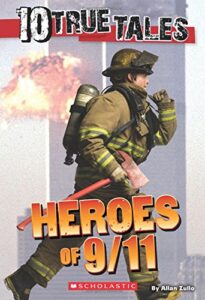
10 True Tales: Heroes of 9/11
By Allan Zallo
When Captain Jay Jonas of the Fire Department of New York hears an emergency radio message about the World Trade Center, he has no idea of the terrible conditions he and his team will face. Arriving at the burning building, the firefighters must summon all their courage. On the same morning, just outside Washington, D.C., a jetliner piloted by terrorists slams into the Pentagon. Can Colonel Philip McNair save lives inside the flaming building?
From the World Trade Center and the Pentagon to a hijacked plane above Pennsylvania, these ten stories of true American heroes on the day that changed America — September 11, 2001. Grades 3-7
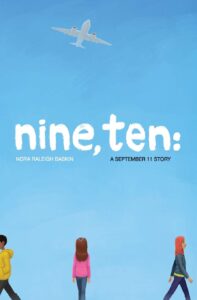
Nine, Ten: A September 11 Story
By Nora Raleigh Baskin
Ask anyone: September 11, 2001, was serene and lovely, a perfect day—until a plane struck the World Trade Center.
But right now it is a few days earlier, and four kids in different parts of the country are going about their lives. Sergio, who lives in Brooklyn, is struggling to come to terms with the absentee father he hates and the grandmother he loves. Will’s father is gone, too, killed in a car accident that has left the family reeling. Naheed has never before felt uncomfortable about being Muslim, but at her new school she’s getting funny looks because of the head scarf she wears. Aimee is starting a new school in a new city and missing her mom, who has to fly to New York on business.
These four don’t know one another, but their lives are about to intersect in ways they never could have imagined. Nora Raleigh Baskin weaves together their stories into a novel about that seemingly perfect September day—the day our world changed forever. Grades 3-7
The books descriptions used are primarily from the publishers.
If you like this post, then please consider sharing it and/or leaving a comment below. Thank you! Barbara Lowell, Children’s Author
To Learn More Visit the National September 11 Memorial and Museum https://www.911memorial.org/
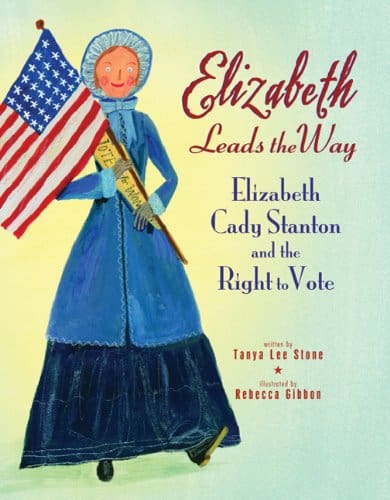
Elizabeth Leads the Way: Elizabeth Cady Stanton and the Right to Vote
By Tanya Lee Stone, Illustrated by Rebecca Gibbon
Elizabeth Cady Stanton stood up and fought for what she believed in. From an early age, she knew that women were not given rights equal to men. But rather than accept her lesser status, Elizabeth went to college and later gathered other like-minded women to challenge the right to vote. Here is the inspiring story of an extraordinary woman who changed America forever because she wouldn’t take “no” for an answer. Grades 1-5
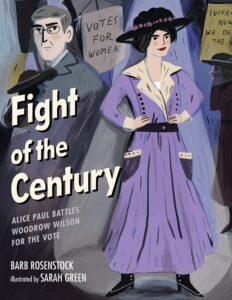
Fight of the Century: Alice Paul Battles Woodrow Wilson for the Vote
By Barb Rosenstock, Illustrated by Sarah Green
When Woodrow Wilson was elected President, he didn’t know that he would be participating in one of the greatest fights of the century: the battle for women’s right to vote. The formidable Alice Paul led the women’s suffrage movement and saw President Wilson’s election as an opportunity to win the vote for women. She battered her opponent with endless strategic arguments and carefully coordinated protests, calling for a new amendment to grant women the right to vote.
With a spirit and determination that never quit, even when peaceful protests were met with violence and even when many women were thrown in jail, Paul eventually convinced President Wilson to support her cause, changing the country forever. Framed as a boxing match, this book provides a fascinating and compelling look at an important moment in American history. Grades 2-5

The Voice that Won the Vote: How One Woman’s Words Made History
By Elisa Boxer, Illustrated by Vivien Mildenberger
In August of 1920, women’s suffrage in America came down to the vote in Tennessee. If the Tennessee legislature approved the 19th amendment it would be ratified giving all American women the right to vote. The historic moment came down to a single vote. The voter who tipped the scale toward equality did so because of a powerful letter from his mother. Febb Burn urged her son Harry to “Vote for suffrage and don’t forget to be a good boy.” The Voice That Won the Vote is the story of Febb, Harry, and the letter than gave all American women a voice. Grades 2-5
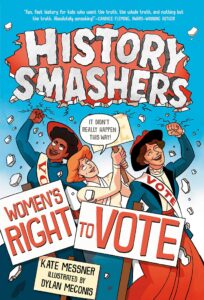
History Smashers: Women’s Right to Vote
By Kate Messner, Illustrated by Dylan Meconis
In 1920, Susan B. Anthony passed a law that gave voting rights to women in the United States. RIGHT?
WRONG! Susan B. Anthony wasn’t even alive when the Nineteenth Amendment was ratified. Plus, it takes a lot more than one person to amend the constitution.
The truth is, it took millions of women to get that amendment into law. They marched! They picketed! They even went to jail. But in the end, it all came down to a letter from a state representative’s mom. No joke.
Through illustrations, graphic panels, photographs, sidebars, and more, Kate Messner smashes history by exploring the little-known details behind the fight for women’s suffrage. Grades 3-7
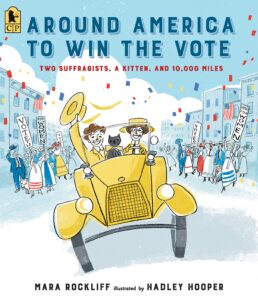
Around America to Win the Vote:
Two Suffragists, a Kitten, and 10,000 Miles
By Mara Rockliff, Illustrated by Hadley Hooper
In April 1916, Nell Richardson and Alice Burke set out from New York City in a little yellow car, embarking on a bumpy, muddy, unmapped journey ten thousand miles long. They took with them a teeny typewriter, a tiny sewing machine, a wee black kitten, and a message for Americans all across the country: Votes for Women!
The women’s suffrage movement was in full swing, and Nell and Alice would not let anything keep them from spreading the word about equal voting rights for women. Braving blizzards, deserts, and naysayers—not to mention a whole lot of tires stuck in the mud—the two courageous friends made their way through the cities and towns of America to further their cause. Grades K-3
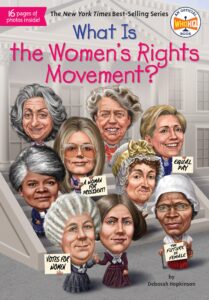
What Is the Women’s Right to Vote?
By Deborah Hopkinson, Illustrated by Laurie A. Conley
From Susan B. Anthony and Elizabeth Cady Stanton to Gloria Steinem and Hillary Clinton, women throughout US history have fought for equality. In the nineteenth and early twentieth centuries, women were demanding the right to vote. During the 1960s, equal rights and opportunities for women–both at home and in the workplace–were pushed even further. And in the more recent past, Women’s Marches have taken place across the world. Celebrate how far women have come with this inspiring read! 8-12 years

Miss Paul and the President:
The Creative Campaign for Women’s Right to Vote
By Dean Robbins, Illustrated by Nancy Zhang
When Alice Paul was a child, she saw her father go off to vote while her mother had to stay home. But why should that be? So Alice studied the Constitution and knew that the laws needed to change. But who would change them?
She would! In her signature purple hat, Alice organized parades, wrote letters and protested outside the White House. She even met with President Woodrow Wilson, who told her there were more important issues to worry about than women voting. But nothing was more important to Alice. So she kept at it, and soon President Wilson was persuaded. This unsung hero will show young voters-to-be how important it is to never back down from a cause you believe in. Preschool – Grade 3

Elizabeth Started All the Trouble
By Doreen Rappaport, Illustrated by Matt Faulkner
She couldn’t go to college.
She couldn’t become a politician.
She couldn’t even vote.
But Elizabeth Cady Stanton didn’t let that stop her.
She called on women across the nation to stand together and demand to be treated as equal to men – and that included the right to vote. It took nearly seventy-five years and generations of women fighting for their rights through words, through action, and through pure determination . . . for things to slowly begin to change.
With the help of these trailblazers’ own words, Doreen Rappaport shows readers just how far this revolution has come, and inspires them to keep it going! Preschool – Grade 3
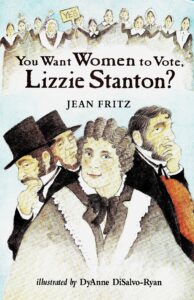
You Want Women to Vote Lizzie Stanton?
By Jean Fritz, Illustrated by Dyane DiSalvo Ryan
This biography of Elizabeth Cady Stanton is as spirited as the women’s rights pioneer herself.
Who says women shouldn’t speak in public? And why can’t they vote? These are questions Elizabeth Cady Stanton grew up asking herself. Her father believed that girls didn’t count as much as boys, and her own husband once got so embarrassed when she spoke at a convention that he left town.
Luckily Lizzie wasn’t one to let society stop her from fighting for equality for everyone. And though she didn’t live long enough to see women get to vote, our entire country benefited from her fight for women’s rights. Grades 3-7
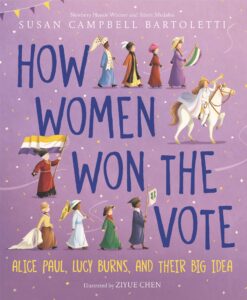
How Women Won the Right to Vote:
Alice Paul, Lucy Burns, and Their Big Idea
By Susan Campbell Bartoletti, Illustrated by Ziyue Chen
From Newbery Honor medalist Susan Campbell Bartoletti in time to celebrate the 100th anniversary of women’s suffrage in America comes the story of the little-known DC Women’s March of 1913.
Bartoletti introduces readers to suffragists Alice Paul and Lucy Burns. They met in a London jail and fought their way through hunger strikes, jail time, and much more to win a long, difficult victory for America and its women.
Includes extensive back matter and dozens of archival images to evoke the time period between 1909 and 1920. Grades 3-7
The book descriptions used in this post are primarily from the publishers.
If you like this post, then please consider sharing it and/or leaving a comment below. Thank you! Barbara Lowell, Children’s Author
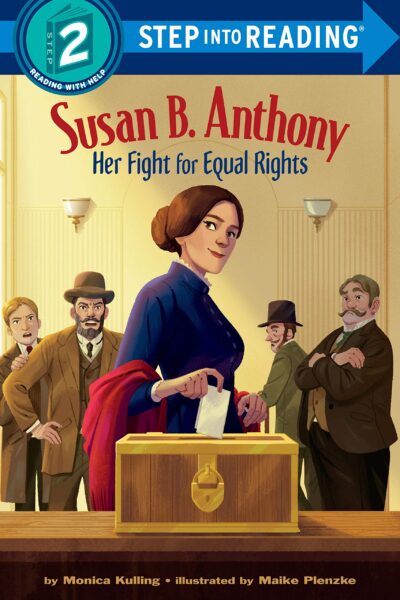
Susan B. Anthony: Her Fight for Equal Rights
By Monica Kulling, Illustrated by Maike Plenzke
“It’s not fair.” Susan B. Anthony was very concerned about fairness and equality for women and girls in America. She knew it wasn’t fair to pay a woman less than a man for the same job. She knew it wasn’t fair not to allow women to vote in elections. In fact, it was illegal for women to vote. But she felt so strongly, she voted in an election–and was arrested–anyway.
Young readers will learn about young Susan B. Anthony and how she grew up to become a suffragette–a fighter for women’s equality. She joined forces with Elizabeth Cady Stanton and others and gave speeches around the country to gain support for women’s right to vote. She fought her whole life, and believed that “failure is impossible.” She was right; her work made the 19th Amendment to the Constitution possible!
Step 3 Readers feature engaging characters in easy-to-follow plots about popular topics–for children who are ready to read on their own. 4-6 years.

Susan B. Anthony
By Alexandra Wallner
During Susan B. Anthony’s life, women and men were not considered equal. Women could not own property or vote; nor could they receive good educations. But Susan envisioned a time when women would be treated fairly and so she became a voice for change.
Her speeches and articles about women’s suffrage made her unpopular–people threw rotten eggs at her and even threatened her life–yet she did not give up. In clear and simple words and jewel-like paintings, here is the essential story of the woman whose passion for justice led to the passing of the Nineteenth Amendment, which gave women the right to vote. 6-9 years
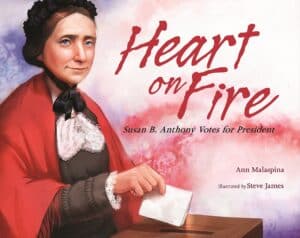
Heart on Fire: Susan B. Anthony Votes For President
By Ann Malaspina, Illustrated by Steve James
On November 5, 1872, Susan B. Anthony made history–and broke the law–when she voted in the U.S. presidential election, a privilege that had been reserved for men. She was arrested, tried, and found guilty: “The greatest outrage History every witnessed,” she wrote in her journal. It wasn’t until 1920 that women were granted the right to vote, but the civil rights victory would not have been possible without Susan B. Anthony’s leadership and passion to stand up for what was right. 4-8 years

Who Was Susan B. Anthony?
By Pam Pollack and Meg Belviso, Illustrated by Mike Lacey
Susan B. Anthony may be an international icon but her campaign for women’s rights had personal roots. Working as a school teacher in New York, Anthony refused to settle for less pay than her male colleagues which ignited her lifelong devotion to women’s equality. Anthony toured the United States and Europe giving speeches and publishing articles as one of the most important advocates of women’s rights. Learn more about the woman behind the movement.8-12 years

Susan B. Anthony: Fighter for Women’s Rights
By Deborah Hopkinson, Illustrated by Amy June Bates
Unlike most girls of her time, Susan B. Anthony received an education. And besides reading and writing, her schooling taught her that women should have the same rights as men, above all the right to vote. So from the time she was a young woman until the day she died, Susan worked very hard to change America and make her dream reality. 6-8 years
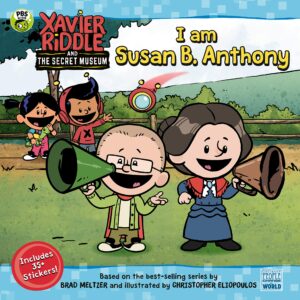
I Am Susan B. Anthony
By Nancy Parent
Brad feels left out when Xavier and Yadina take a vote without him. Thanks to Susan B. Anthony, they learn that everyone should have a vote! This episode-based 8×8 will focus on the traits that made our heroes great–the traits that kids can aspire to in order to live heroically themselves. 3-5 years
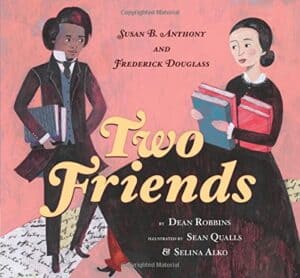
Two Friends: Susan B. Anthony and Frederick Douglass
By Dean Robbins, Illustrated by Sean Qualls and Selina Alko
Some people had rights, while others had none.
Why shouldn’t they have them, too?
Two friends, Susan B. Anthony and Frederick Douglass, get together for tea and conversation. They recount their similar stories fighting to win rights for women and African Americans. The premise of this particular exchange between the two is based on a statue in their hometown of Rochester, New York, which shows the two friends having tea. 4-8 years

Why Couldn’t Susan B. Anthony Vote?
And Other Questions About Women’s Suffrage
By Mary Kay Carson
Who was Susan B. Anthony—what did she stand for, why was she arrested, and how did she fight for women’s right to vote? And did she ever see her dream of woman’s suffrage come true? From the first women’s rights convention at Seneca Falls, New York, to the enactment of the 19th Amendment, this lively chronicle introduces Anthony and the American suffragist movement. 7 and up

Susan B. Anthony: Champion for Voting Rights
By Mark Shulman, Illustrated by Kelly Tindall
This is a biography of the woman who was at the forefront of the women’s suffrage movement in the late nineteenth and early twentieth centuries. Along with other social reformers such as Elizabeth Cady Stanton and Frederick Douglass, Anthony not only paved the way for women seeking the right to vote but also spoke out against the institution of slavery, at great personal risk. Full-color illustrations and historically accurate text make this biography an entertaining, educational, and inspiring read for those who enjoy history and graphic novels. 8-12 years
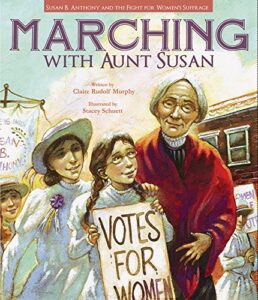
Marching With Aunt Susan
By Claire Rudolf Murphy, Illustrated by Stacy Schuett
This is the inspiring story of the fight for women’s suffrage, based on the experiences of a real girl. All Bessie wants is to go hiking with her father and brothers. But it’s 1896, and girls don’t get to hike. They can’t vote either, which Bessie discovers when Susan B. Anthony comes to town to help lead the campaign for women’s suffrage. Stirred to action, Bessie joins the movement and discovers that small efforts can result in small changes―and maybe even big ones.
Inspired by the diary of the real Bessie Keith Pond, a ten-year-old girl who lived in California during the suffrage campaign, this story offers a thought-provoking introduction to the fight for women’s rights. A story of hope and determination, Marching with Aunt Susan reminds readers that society cannot evolve unless people―even young people―dare to take a stand. 6-10 years
The book descriptions used are primarily from the publishers.
If you like this post, then please consider sharing it and/or leaving a comment below. Thank you! Barbara Lowell, Children’s Author























































































